Abstract
1. The role of catecholamines in thermogenesis has been investigated in trained young pigs in various situations which increases heat production. Plasma noradrenaline and adrenaline concentrations were estimated by radioenzymic assay of samples taken from an indwelling jugular catheter to prevent disturbance and stress. 2. During 3 hr at ambient temperatures of between 25 and -5 degrees C, there was curvilinear increase in noradrenaline concentrations as temperature decreased, but adrenaline did not change. After 1-3 days at 5 or 1 degrees C, the concentrations of both amines were similar to those found at thermal neutrality. 3. Cooling the cervical region of the spinal cord resulted in a large increase in plasma noradrenaline whereas local cooling of the hypothalamus was associated with a small increase in the hormone. When cooling either region of the central nervous system, plasma adrenaline concentrations did not change. 4. During exposure to 45 degrees C, rectal temperature increased to 43 degrees C. Concentrations of catecholamines remained low or declined until the rectal temperature was above 41.5 degrees C when the concentrations increased in most animals. 5. Induced physical activity lasting 40 min was associated with an increase in both noradrenaline and adrenaline concentrations. 6. Blood samples from the inferior vena cava, just cephalad to the outlet of the adrenal veins, had much higher concentrations of noradrenaline during cold exposure than those taken simultaneously from the jugular vein. Therefore, at least part of the increase in noradrenaline concentrations reported above may have been due to release of the hormone from the adrenal medulla. 7. It is concluded that during short-term exposure to cold, and in exercise, there is a rapid catecholamine response, producing concentrations in the blood which could be high enough to stimulate thermogenesis. During longer-term cold exposure, catecholamine output is low and other factors must be of greater importance in maintaining thermogenic processes. Further, catecholamine output may result from thermal stimuli not only from outside the external surface of the animal but also from within the central nervous system.
Full text
PDF
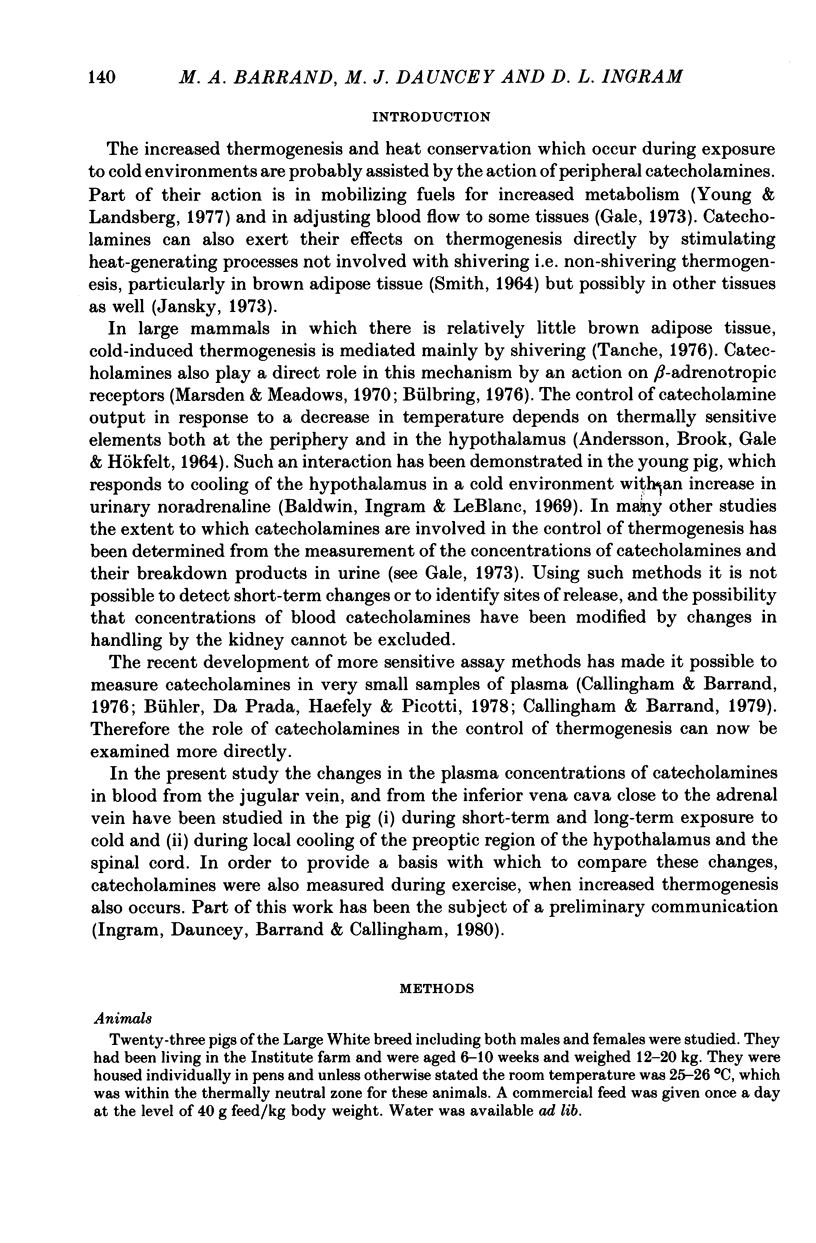

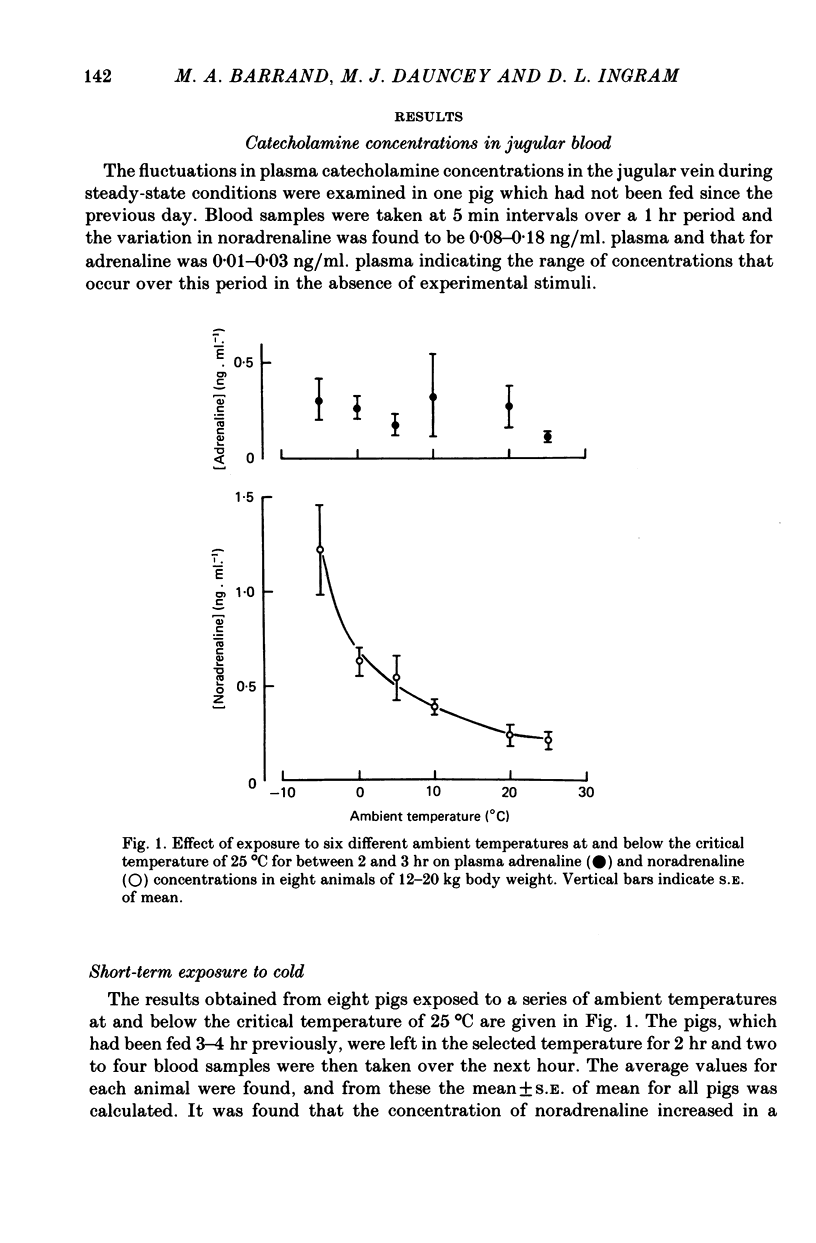
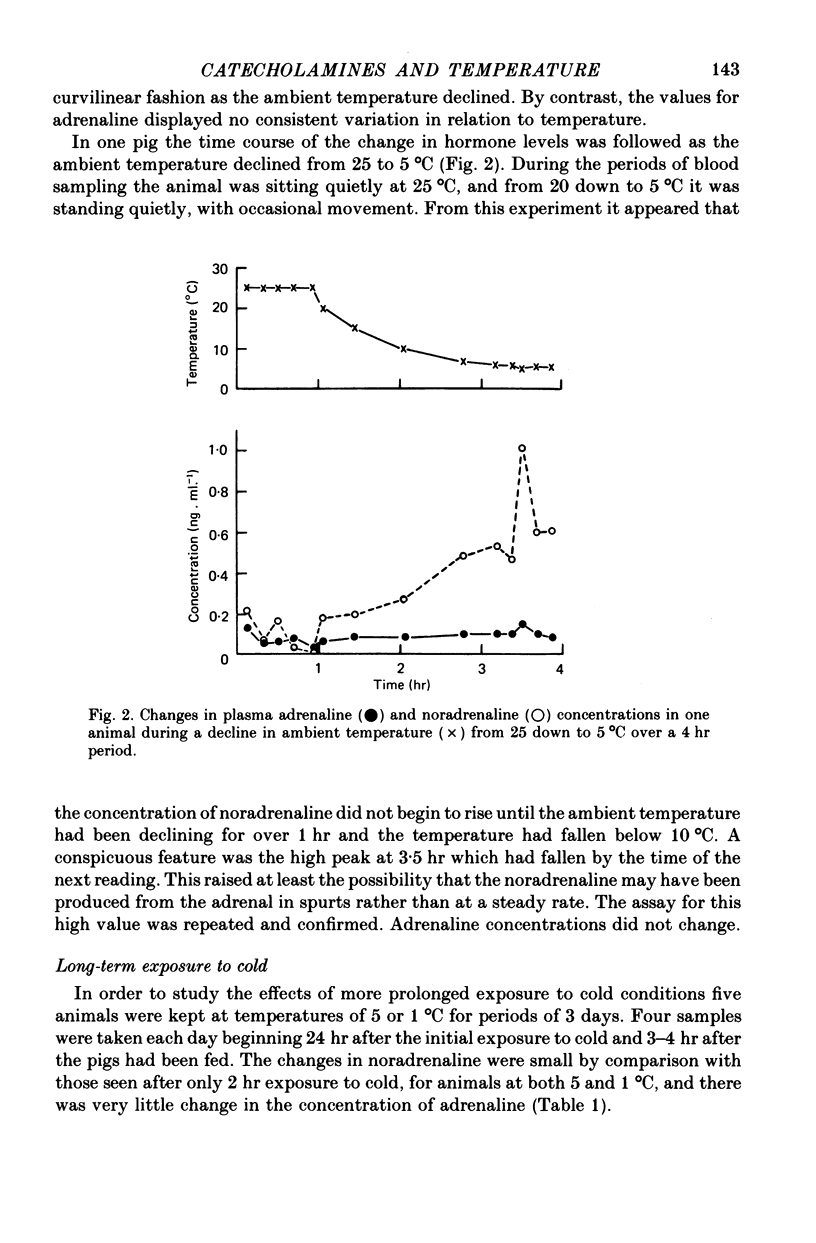
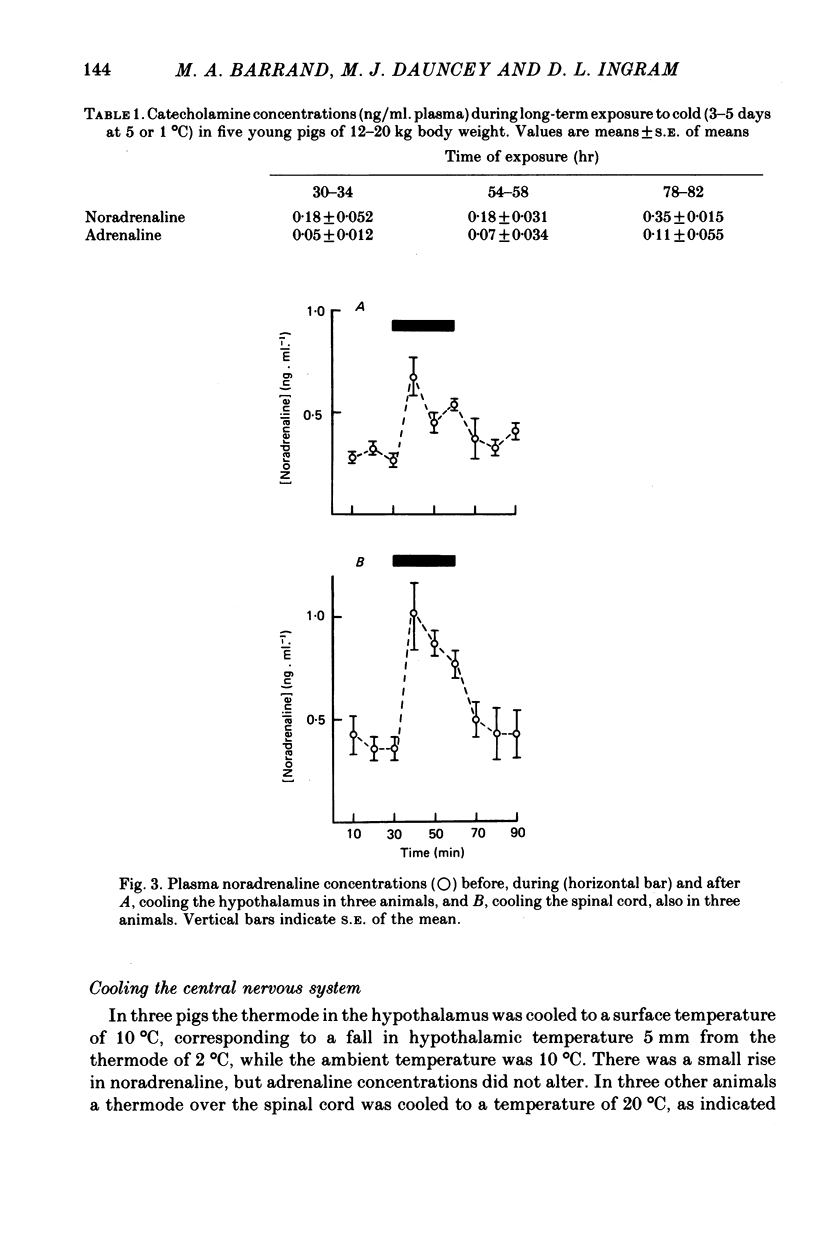
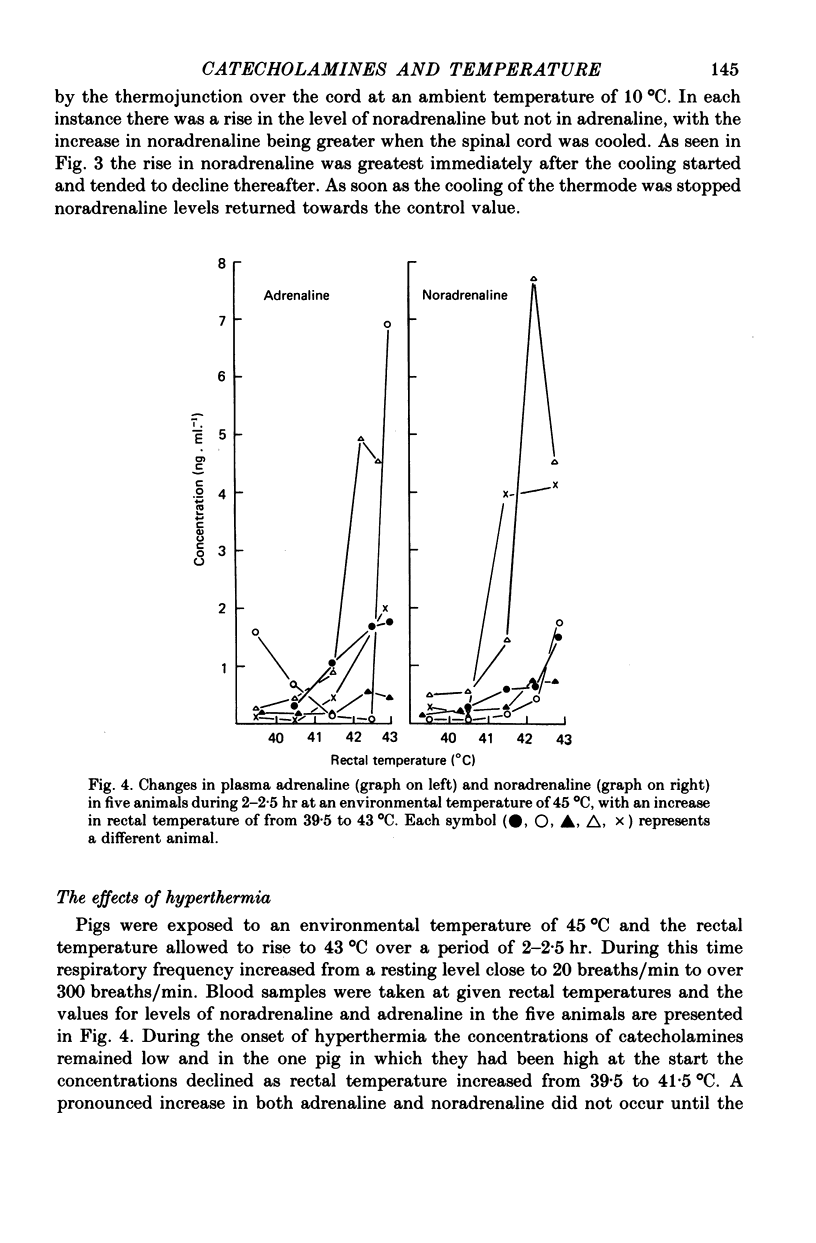
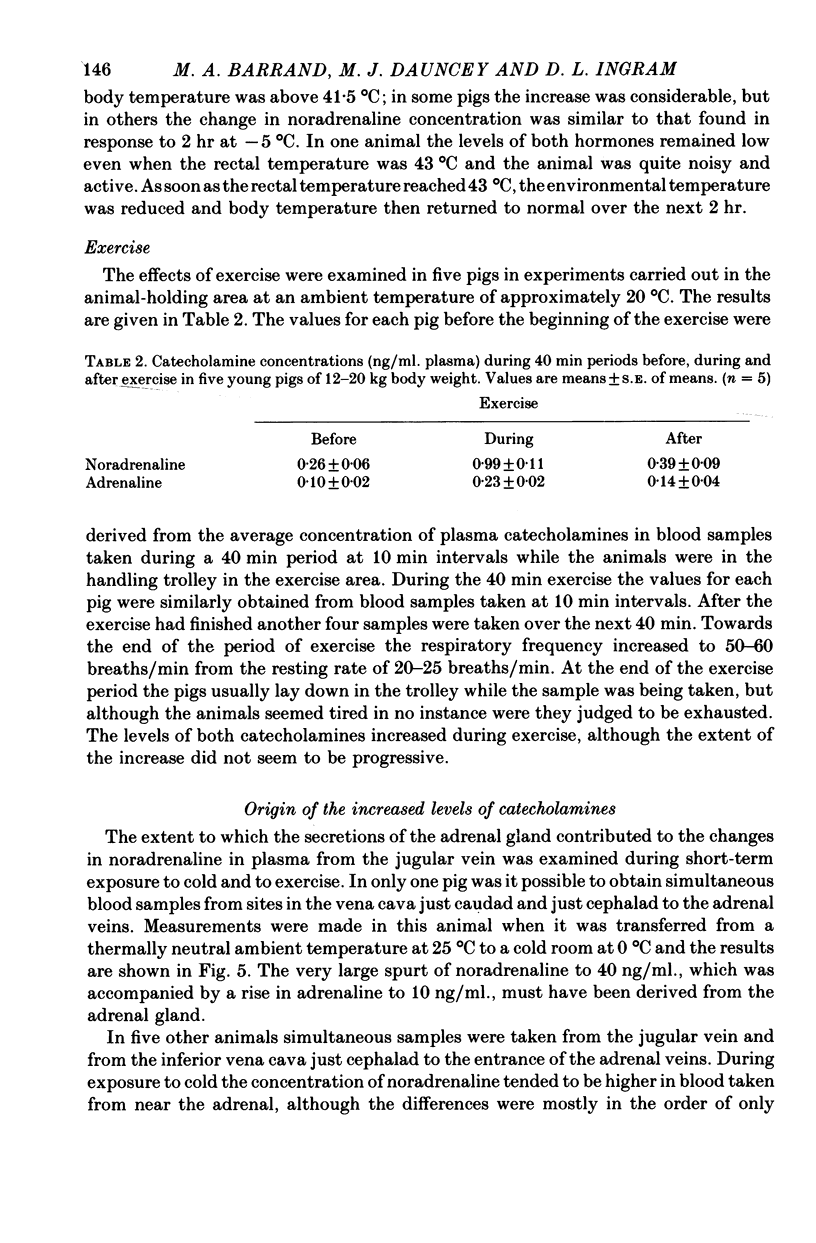
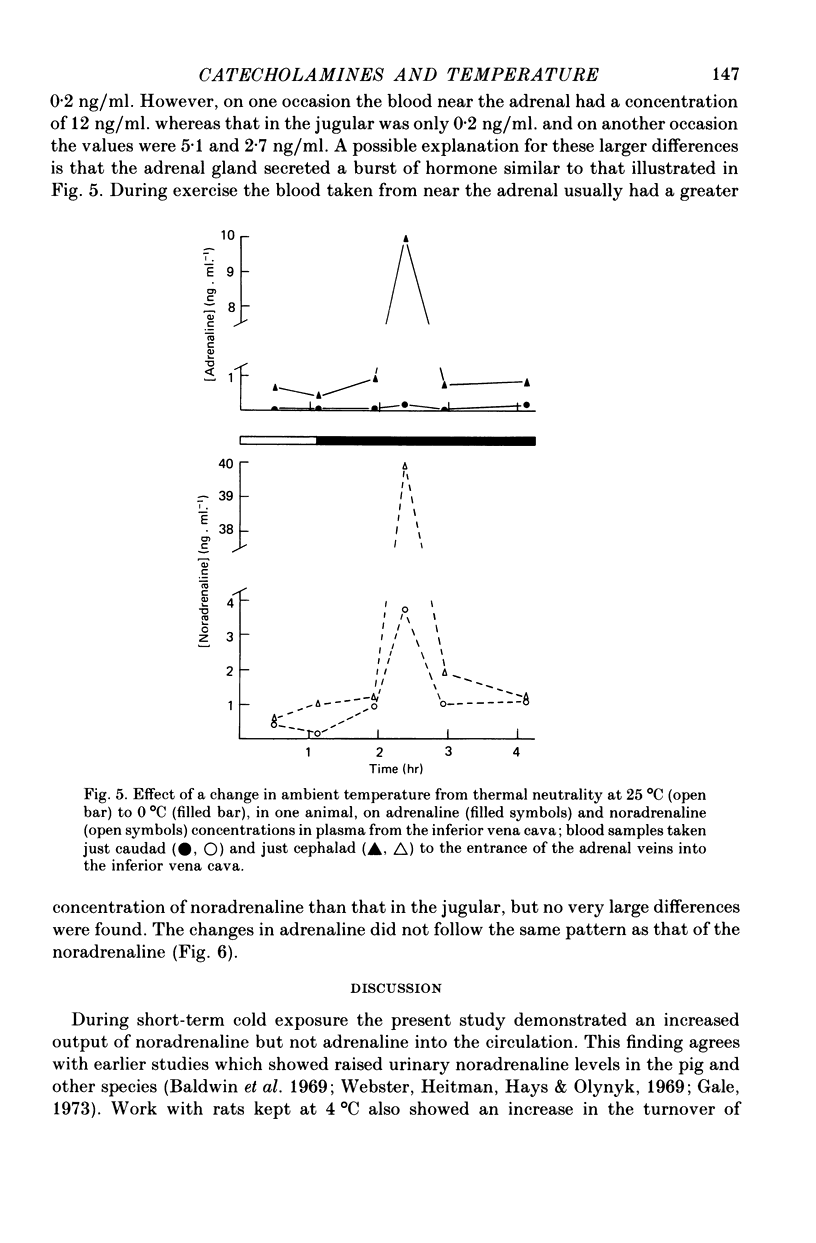
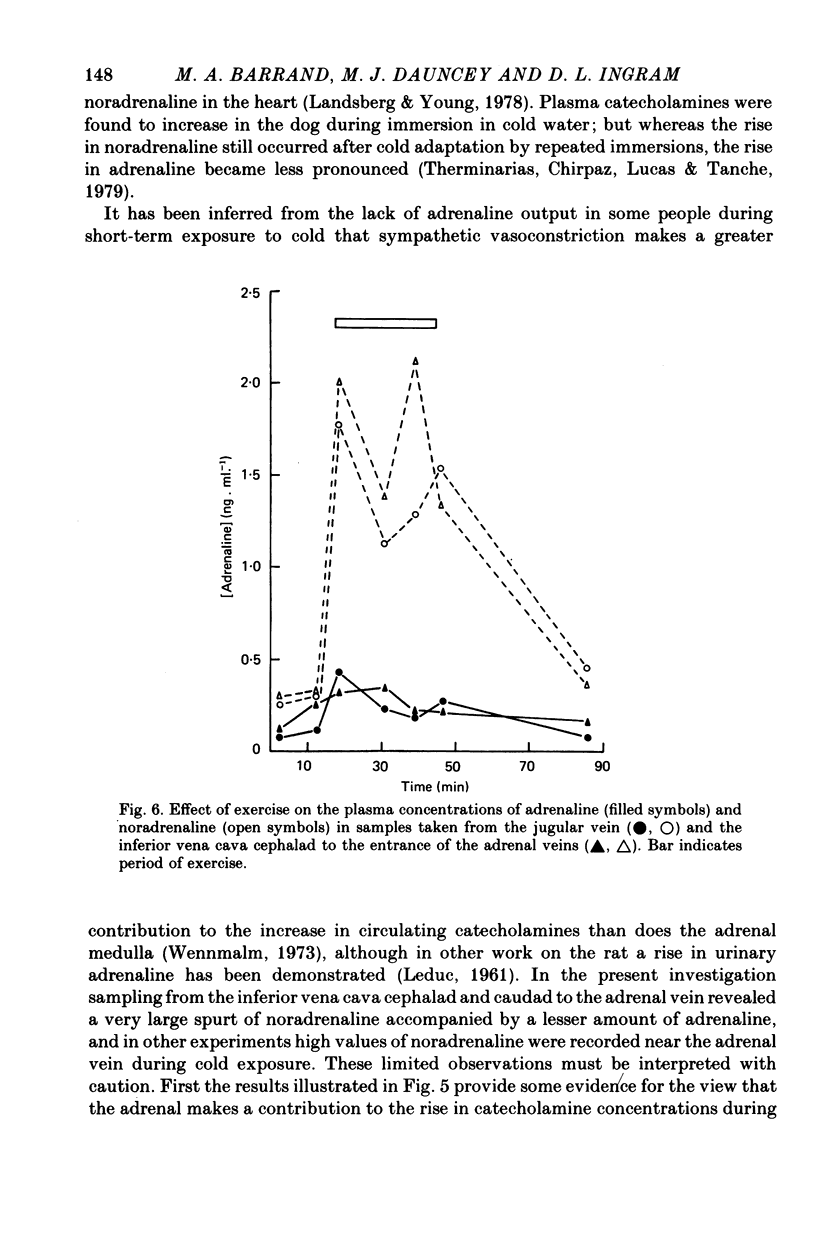
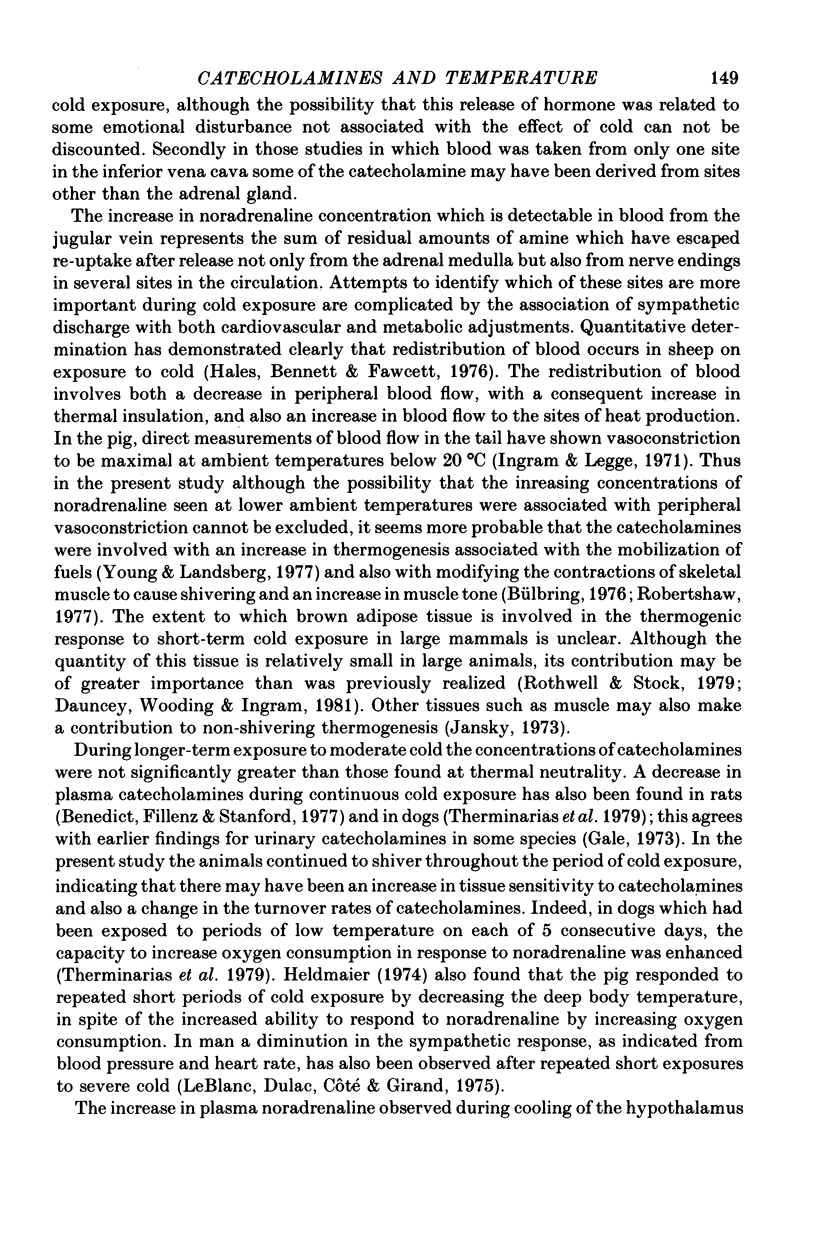
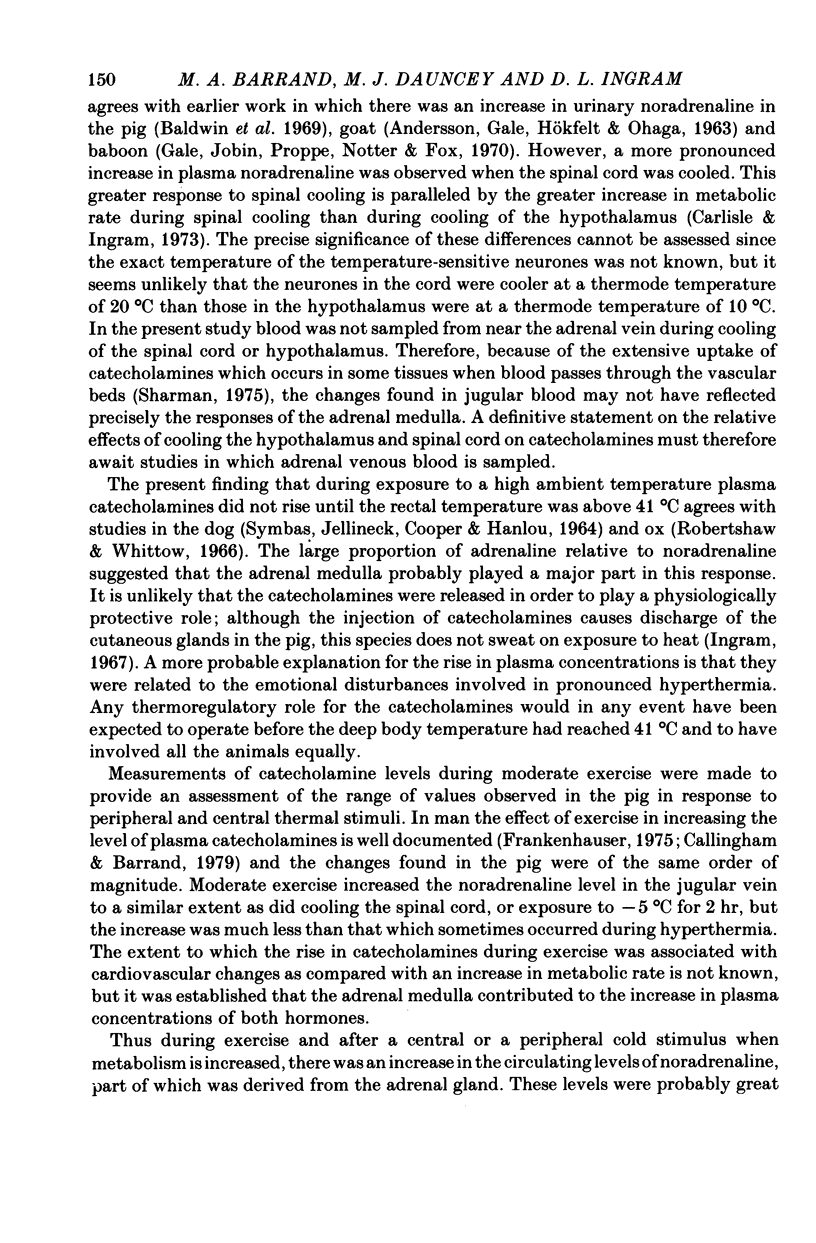
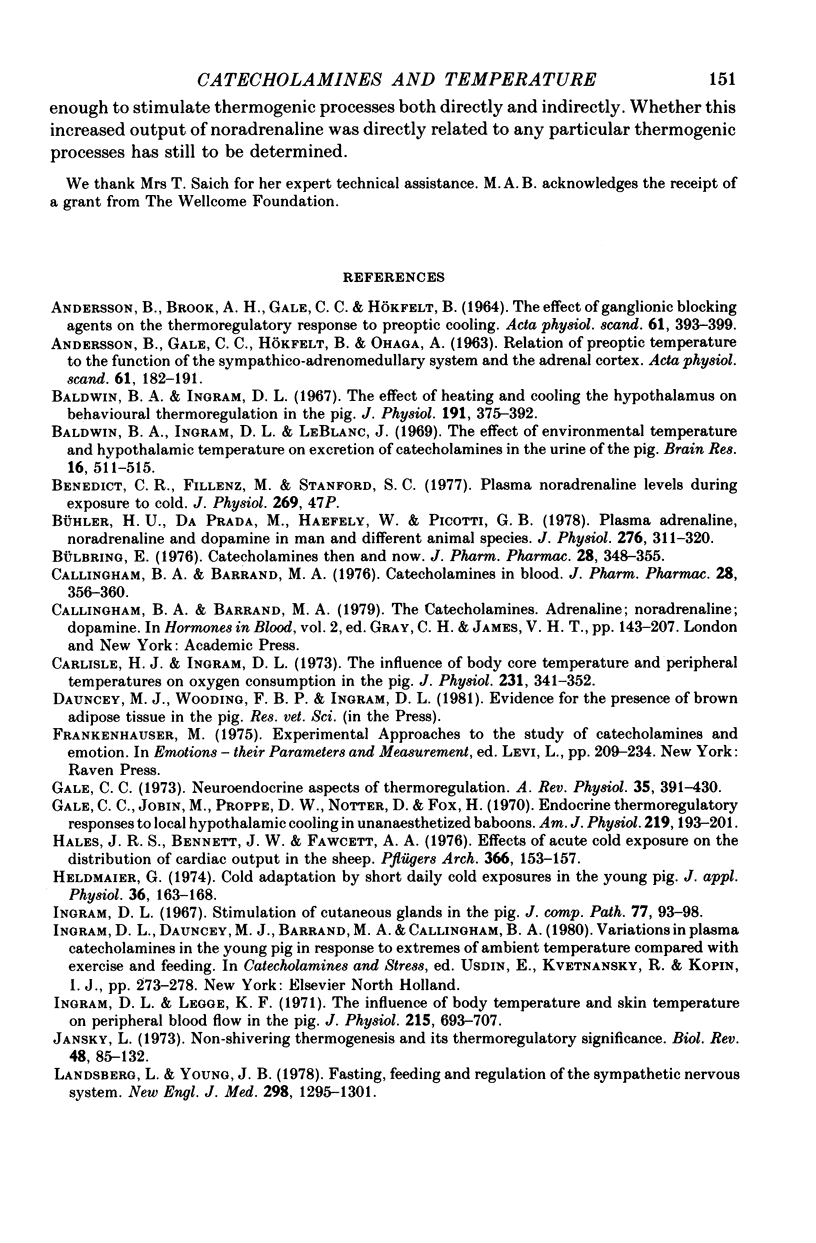

Selected References
These references are in PubMed. This may not be the complete list of references from this article.
- ANDERSSON B., BROOK A. H., GALE C. C., HOEKFELT B. THE EFFECT OF A GANGLIONIC BLOCKING AGENT ON THE THERMOREGULATORY RESPONSE TO PREOPTIC COOLING. Acta Physiol Scand. 1964 Aug;61:393–399. [PubMed] [Google Scholar]
- ANDERSSON B., GALE C. C., HOEKFELT B., OHGA A. RELATION OF PREOPTIC TEMPERATURE TO THE FUNCTION OF THE SYMPATHICO--ADRENOMEDULLARY SYSTEM AND THE ADRENAL CORTEX. Acta Physiol Scand. 1964 May-Jun;61:182–191. doi: 10.1111/j.1748-1716.1964.tb02954.x. [DOI] [PubMed] [Google Scholar]
- Baldwin B. A., Ingram D. L. Effect of heating & cooling the hypothalamus on behavioral thermoregulation in the pig. J Physiol. 1967 Jul;191(2):375–392. doi: 10.1113/jphysiol.1967.sp008256. [DOI] [PMC free article] [PubMed] [Google Scholar]
- Baldwin B. A., Ingram D. L., LeBlanc J. The effects of environmental temperature and hypothalamic temperature on excretion of catecholamines in the urine of the pig. Brain Res. 1969 Dec;16(2):511–515. doi: 10.1016/0006-8993(69)90243-1. [DOI] [PubMed] [Google Scholar]
- Benedict C. R., Fillenz M., Stanford S. C. Plasma noradrenaline levels during exposure to cold [proceedings]. J Physiol. 1977 Jul;269(1):47P–48P. [PubMed] [Google Scholar]
- Bühler H. U., da Prada M., Haefely W., Picotti G. B. Plasma adrenaline, noradrenaline and dopamine in man and different animal species. J Physiol. 1978 Mar;276:311–320. doi: 10.1113/jphysiol.1978.sp012235. [DOI] [PMC free article] [PubMed] [Google Scholar]
- Bülbring E. Catecholamines then and now. J Pharm Pharmacol. 1976 Apr;28(4 Suppl):348–355. doi: 10.1111/j.2042-7158.1976.tb04178.x. [DOI] [PubMed] [Google Scholar]
- Callingham B. A., Barrand M. A. Catecholamines in blood. J Pharm Pharmacol. 1976 Apr;28(4 Suppl):356–360. doi: 10.1111/j.2042-7158.1976.tb04179.x. [DOI] [PubMed] [Google Scholar]
- Carlisle H. J., Ingram D. L. The influence of body core temperature and peripheral temperatures on oxygen consumption in the pig. J Physiol. 1973 Jun;231(2):341–352. doi: 10.1113/jphysiol.1973.sp010236. [DOI] [PMC free article] [PubMed] [Google Scholar]
- Gale C. C., Jobin M., Proppe D. W., Notter D., Fox H. Endocrine thermoregulatory responses to local hypothalamic cooling in unanesthetized baboons. Am J Physiol. 1970 Jul;219(1):193–201. doi: 10.1152/ajplegacy.1970.219.1.193. [DOI] [PubMed] [Google Scholar]
- Gale C. C. Neuroendocrine aspects of thermoregulation. Annu Rev Physiol. 1973;35:391–430. doi: 10.1146/annurev.ph.35.030173.002135. [DOI] [PubMed] [Google Scholar]
- Hales J. R., Bennett J. W., Fawcett A. A. Effects of acute cold exposure on the distribution of cardiac output in the sheep. Pflugers Arch. 1976 Nov 5;366(2-3):153–157. doi: 10.1007/BF00585871. [DOI] [PubMed] [Google Scholar]
- Heldmaier G. Cold adaptation by short daily cold exposures in the young pig. J Appl Physiol. 1974 Feb;36(2):163–168. doi: 10.1152/jappl.1974.36.2.163. [DOI] [PubMed] [Google Scholar]
- Ingram D. L., Legge K. F. The influence of deep body temperatures and skin temperatures on peripheral blood flow in the pig. J Physiol. 1971 Jul;215(3):693–707. doi: 10.1113/jphysiol.1971.sp009492. [DOI] [PMC free article] [PubMed] [Google Scholar]
- Ingram D. L. Stimulation of cutaneous glands in the pig. J Comp Pathol. 1967 Jan;77(1):93–98. doi: 10.1016/s0021-9975(67)80012-4. [DOI] [PubMed] [Google Scholar]
- Janský L. Non-shivering thermogenesis and its thermoregulatory significance. Biol Rev Camb Philos Soc. 1973 Feb;48(1):85–132. doi: 10.1111/j.1469-185x.1973.tb01115.x. [DOI] [PubMed] [Google Scholar]
- Landsberg L., Young J. B. Fasting, feeding and regulation of the sympathetic nervous system. N Engl J Med. 1978 Jun 8;298(23):1295–1301. doi: 10.1056/NEJM197806082982306. [DOI] [PubMed] [Google Scholar]
- LeBlanc J., Dulac S., Côté J., Girard B. Autonomic nervous system and adaptation to cold in man. J Appl Physiol. 1975 Aug;39(2):181–186. doi: 10.1152/jappl.1975.39.2.181. [DOI] [PubMed] [Google Scholar]
- Marsden C. D., Meadows J. C. The effect of adrenaline on the contraction of human muscle. J Physiol. 1970 Apr;207(2):429–448. doi: 10.1113/jphysiol.1970.sp009071. [DOI] [PMC free article] [PubMed] [Google Scholar]
- Robertshaw D., Whittow G. C. The effect of hyperthermia and localized heating of the anterior hypothalamus on the sympatho-adrenal system of the ox (Bos taurus). J Physiol. 1966 Nov;187(2):351–360. doi: 10.1113/jphysiol.1966.sp008094. [DOI] [PMC free article] [PubMed] [Google Scholar]
- Rothwell N. J., Stock M. J. A role for brown adipose tissue in diet-induced thermogenesis. Nature. 1979 Sep 6;281(5726):31–35. doi: 10.1038/281031a0. [DOI] [PubMed] [Google Scholar]
- SYMBAS P. N., JELLINEK M., COOPER T., HANLON C. EFFECT OF HYPERTHERMIA ON PLASMA CATECHOLAMINES AND HISTAMINE. Arch Int Pharmacodyn Ther. 1964 Jul 1;150:132–136. [PubMed] [Google Scholar]
- Tanche M. The adrenal gland and thermoregulation. Isr J Med Sci. 1976 Sep;12(9):1019–1025. [PubMed] [Google Scholar]
- Therminarias A., Chirpaz M. F., Lucas A., Tanche M. Catecholamines in dogs during cold adaptation by repeated immersions. J Appl Physiol Respir Environ Exerc Physiol. 1979 Apr;46(4):662–668. doi: 10.1152/jappl.1979.46.4.662. [DOI] [PubMed] [Google Scholar]
- Webster A. J., Heitman J. H., Hays F. L., Olynyk G. P. Catecholamines and cold thermogenesis in sheep. Can J Physiol Pharmacol. 1969 Aug;47(8):719–724. doi: 10.1139/y69-122. [DOI] [PubMed] [Google Scholar]
- Wennmalm A. Catecholaminergic defense against hypothermia during brief cold exposure. Scand J Clin Lab Invest. 1973 Dec;32(4):305–308. doi: 10.3109/00365517309084351. [DOI] [PubMed] [Google Scholar]
- Young J. B., Landsberg L. Catecholamines and intermediary metabolism. Clin Endocrinol Metab. 1977 Nov;6(3):599–631. doi: 10.1016/s0300-595x(77)80073-x. [DOI] [PubMed] [Google Scholar]


